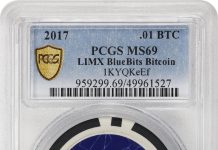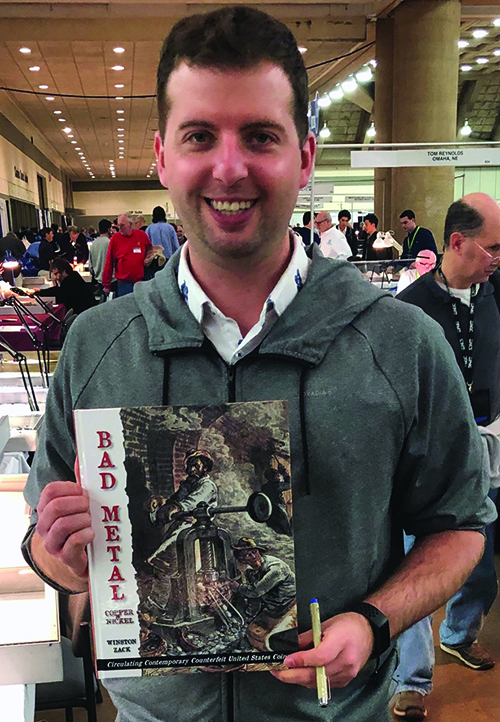
By Winston Zack
For decades, the numismatic community has been plagued by counterfeit U.S. coins of varying quality pouring into the marketplace, deceiving collectors and causing distress. However, there was also a time in the not too distant past when U.S. coins were counterfeited to be passed off and used in circulation as real money.
These are known as ‘circulating contemporary counterfeit U.S. coins.’ I authored a new book which carefully documents these pieces and their respective histories: Bad Metal: Copper and Nickel Circulating Contemporary Counterfeit United States Coins
Bad Metal is a profusely illustrated hard-cover book spanning nearly 300 pages. This is not your standard book on counterfeit coins. It is interactive. It reads as part novel, with dozens of short stories covering diverse topics, while also being part technical manual with meandering content to keep readers of all levels of numismatic experience continuously engaged for easy learning. My book is adorned by hundreds of large, high-quality, full-color images of counterfeit coins and associated paraphernalia to make visual identification as simple as possible.
Tips for Detecting Counterfeits
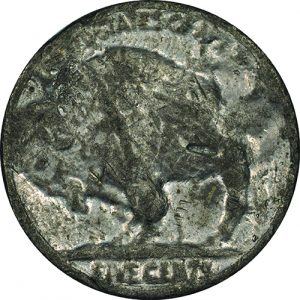
Chapters include topics that cover modern techniques for effectively detecting contemporary counterfeit U.S. coins, differentiating between struck and cast counterfeits, counterfeit U.S. coin laws, and the history of U.S. coin counterfeiting dating back to 1793. The book concludes with chapters dedicated to the history of various copper and nickel denominations, from half-cents through five-cent nickels, including diligently documenting extant varieties, and in several cases illustrating the lives of the actual counterfeiters who made those counterfeit U.S. coin varieties.
Hate or accept them. Loathe or admire them. Counterfeiting U.S. federal money, both paper and coins, has been a major component of U.S. history extending back to at least 1800. One compelling argument is that counterfeiting U.S. money, especially coins, unofficially became a fundamentally important component in the founding and ultimate success of the U.S.
While several researchers have published comprehensive books on counterfeit U.S. paper money, few researchers have tackled contemporary U.S. coins, and those that have done so have focused on a specialized coin type. However, that critically important parallel history of counterfeit U.S. coins made for circulation has subsequently been understudied, and the story, to the best of my knowledge, has previously never been extensively researched.
Bad Metal puts circulating contemporary counterfeit U.S. coins into their proper historical context. My book and the information contained within it was assembled from diligent research compiled over the last six years. It tackles fears and anxiety surrounding counterfeit U.S. coins head-on, while clarifying many myths, legends and misinformation surrounding these counterfeit U.S. coins.
Contemporary Fakes
The first chapter focuses on non-contemporary types of counterfeit U.S. coins which have been made, including reproductions, alterations, restrikes, and other exonumia which deceptively look like circulating contemporary counterfeit U.S. coins but whose original purpose was something different.
The second chapter provides a layout for attributing and describing different circulating contemporary counterfeit U.S. coins. However, in many cases the counterfeits have diverse, interesting, and mysterious history. This chapter also details how circulating contemporary counterfeit U.S. coins should be attributed. Other methods of describing the various attributes of a counterfeit coin, such as manufacturing method, planchet alloy, and die rotation, are also included.
Chapter three is a 20-page long synthesis describing how struck counterfeit U.S. coins were made. It blends the ingredients of planchet production, obverse and reverse die manufacturing, the different types of machinery required, and in some cases the post-production processing. When combined, these different manufacturing processes resulted in a counterfeit coin which, for the counterfeiter’s sake, was deceptive enough to successfully pass-off, at least the first time in circulation.
One of the fundamentally necessary aspects in a project such as this was accurately documenting the relative elemental composition of counterfeit coin planchet alloys. I partnered with ASM Affiliates in Carlsbad, California to nondestructively analyze, through x-ray fluorescence (XRF), the different alloy groups of more than 90% of all currently documented contemporary counterfeit U.S. coin varieties; additional data on specific gravity values is being compiled by Chris Pilliod. Accurately documenting the correct alloy type was also important in elucidating the relative date counterfeit U.S. coins were made, as well as identifying shifting trends in planchet types and production methods employed over time.
Understanding Cast Counterfeiting
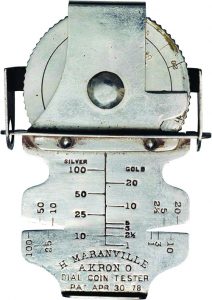
1878, is an ingenious take on the
classic rocker scale with a rotating
dial and counterweight, allowing
for measurement against proper
weight for a full ten coins.
Stack’s Bowers
Cast counterfeiting, as discussed in chapter four, has been largely ignored by researchers. The generally poor quality of these counterfeits have left them with less intrigue and appreciation than their hand-made, die struck counterparts. Cast counterfeiting was probably the most common and abundant method Americans employed in the counterfeit U.S. coin trade. Therefore, it is fundamentally important to understand their production methodology and how trends in materials, both in terms of the mold and the cast counterfeits themselves, evolved and were refined over time.
Potentially, the most important chapter in this book is chapter five: “Detecting Counterfeit U.S. Coins.” This chapter requires the reader to critically think about and analyze the coins he is studying, while providing manageable methods to determine authenticity. Determining authenticity is a process of evaluating numerous attributes in order to attain a level of confidence in order to resolve whether the coin is genuine or counterfeit. As such, a simple worksheet with associated questions was created to make this process as user-friendly and effective as possible for the reader. More in-depth discussion of various aspects to look for in resolving authenticity is described throughout this 22-page chapter.
Another important chapter in this book is chapter six: “Counterfeit U.S. Coin Laws.” The major laws surrounding counterfeit U.S. coins are reproduced, often in their entirety. This includes laws extending back to 1790, before U.S. coins were officially minted, through to the Hobby Protection Act of 1973, as amended in 2014 by the Collectible Coin Protection Act. By reproducing these laws, you can identify how these laws evolved to be more effective in prosecuting counterfeiters and their associates. A brief section was also included on how these laws have been interpreted by legal experts on this subject.
History of Coin Counterfeiting
Chapter seven describes the behavior of counterfeiters and how they organized themselves. The economic investment within the organization and logistics relative to the surrounding area often played active roles in determining how a counterfeit U.S. coin organization was formed, the method of counterfeiting, and ultimately how successful it likely was. This analysis can largely be seen as theoretical, but it uses practical input for many documented examples to develop general trends.
Chapter eight dives deep into the history of U.S. coin counterfeiting from 1793 through 1896. This chapter is divided into eight discrete periods whereupon principally aspects of U.S. policy had direct and indirect effects on U.S. coin mintages and national economics as a whole, which in turn affected trends in U.S. coin counterfeiting behavior over time. Three additional mini stories were included, such as counterfeiting U.S. coins in the penitentiary, which capture specific cultural groups and their involvement in U.S. coin counterfeiting.
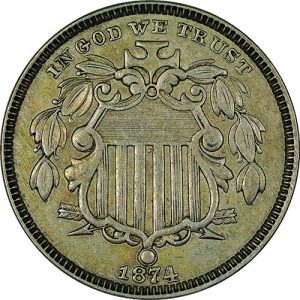
from 1874, was a popular category among early counterfeiters, so much so it’s reported that at one time there were more than 30 varieties.
Of particular interest to collectors of copper denominations, including half-cents, large cents, small cents, and two-cent pieces, is chapter nine: “Copper Counterfeits.” Why would someone counterfeit a cent or half-cent? Were two-cent pieces counterfeited? Was there an economic advantage of counterfeiting such small denominations? This chapter attempts to answer these questions for each denomination and coin type, while also documenting several examples of casts, transfer dies, and hand-made, die struck counterfeits.
Of particular note are plate images dedicated to all documented examples the counterfeit 1818 large cent and 1848 Small Date large cent. There is even an example of a Lincoln head wheat stalk cent struck from hand-made dies.
Finally, chapter ten concludes with nickel counterfeits, spanning from three-cent pieces through the different five-cent designs. While three-cent nickels may not be popular to collect, they have a relatively rich history of being counterfeited, at least for a brief period of time. In contrast, five-cent nickels have a long history of being counterfeited in massive quantities. Shield nickels were an early target by die makers, with at least three or four documented counterfeit coin families, and 32 different varieties being produced.
Liberty Head Nickels
Counterfeit Liberty Head nickels are best known by Josh Tatum, the deaf mute, who allegedly gold-plated thousands of 1883 CENTS-less racketeer Liberty nickels and successfully passed them off as half eagle gold pieces. But did Mr. Tatum really exist, and is there any truth to this classic story? There are also significant updates on Francis Henning and his counterfeit Jefferson nickel operation. What many readers may find particularly interesting is that Henning, while well-known today, did not produce nearly as many counterfeit nickels as his earlier contemporaries, including the largest five-cent nickel operation of them all who were striking counterfeit Buffalo nickels.
It is my hope that readers appreciate the information contained within as well as learn and benefit from the content it contains. It was a privilege to study and document hundreds of different counterfeit U.S. coin varieties from every denomination and type, of which most people have never seen before or realized existed.
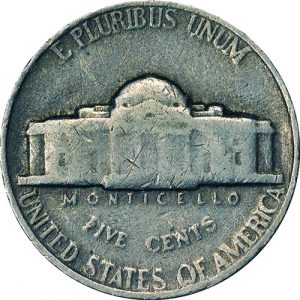
in counterfeiting Jefferson nickles,
like this example, is more thoroughly
known, his productivity is less than that of other earlier makers.
One of my favorite parts in assembling this book was selectively including interesting and relevant images of specific newspaper clippings which described various counterfeit U.S. coin events. This scrapbook-style approach ultimately made me feel more connected and engaged with the past. However, the ultimate accomplishment and satisfaction for me was figuring out who the people were who made specific counterfeit U.S. coin varieties, and thus attaching provenance to specific counterfeit coin varieties.
When I started this project, I suspected that the secretive nature of counterfeiting was such that the provenance of nearly all pieces had been lost with time. While this is still largely the case, we are slowly beginning to reconstruct the past one piece of research and documentation at a time.
There are many contemporary counterfeit U.S. coins hiding in coin dealer boxes, collections, and elsewhere. My goal is not just to tell the story as we know it at the time of publication, but to continue to grow our understanding of this subject long into the future. This is why I created a website dedicated to on-going research on contemporary counterfeit U.S. coins. This website is badmetalcoin.com.
If you are interested in contributing to the two future publications, including sharing images of contemporary counterfeit U.S. coins, please feel free to contact me: Winston.S.Zack@gmail.com.
Ordering details:
You can order Bad Metal: Copper and Nickel Circulating Contemporary Counterfeit United States Coins at badmetalcoin.com/shop. The price of the regular edition is $69 plus shipping.


